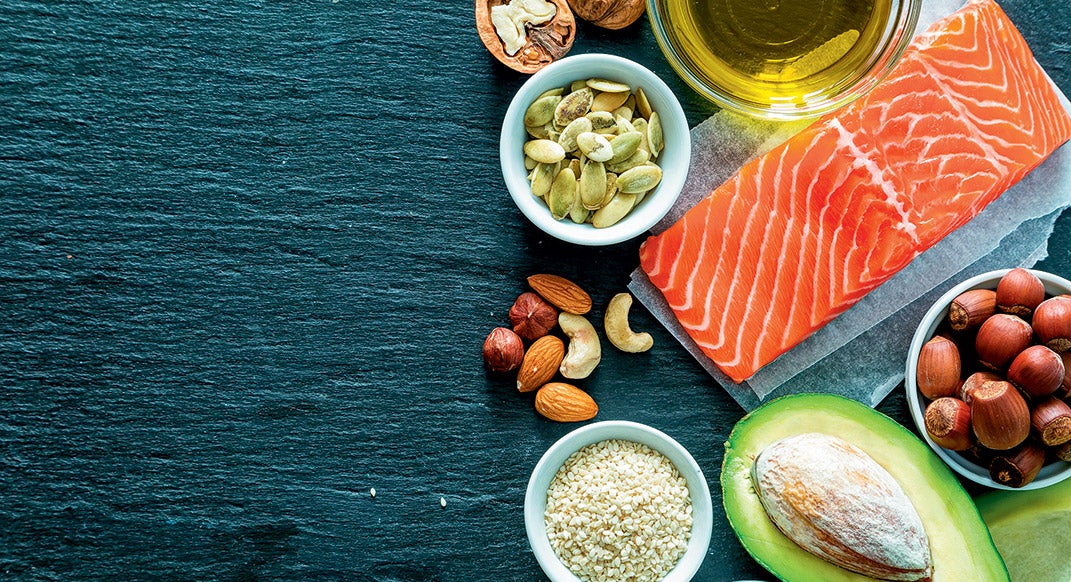Is Fat the New Fast?

If there’s one universal truth about long-distance runners, it’s that we love carbs. Pre-race pasta, mid-run gels and celebratory burgers and beers are our go-tos. But there might be a better way to fuel: fat adaptation.
Some athletes and researchers are testing the effects of two new, fat-focused diets and finding that they may help the body burn fuel more efficiently during competition. Thanks to low-carbohydrate/high-fat (LCHF) and ketogenic diets, fat may no longer be the bad guy.
Fat as Fuel
Generally, runners’ bodies use fuel stored in the form of glycogen, which is easily and quickly metabolized. This means primarily burning carbohydrates, hence the popularity of “carb loading.” In contrast, think of fat stores as the body’s emergency fuels. It takes more energy to break down and synthesize fat, so it’s reserved until glycogen supply is nearing exhaustion.
Dr. Lize Havemann-Nel of North-West University in South Africa says that during a period of four to five days of consuming a higher percentage of fat calories and a lower percentage of carbohydrates, “the body ‘retools’ itself to use fat more efficiently during exercise with the aim to ‘spare’ muscle glycogen.”
Havemann-Nel and her colleague Dr. Julia Goedecke put endurance athletes through several time-trial studies to monitor the results of several LCHF days followed by one or two days of carbohydrate loading. The results were intuitive: the athletes burned the fuel they took in, utilizing fat instead of stored glycogen.
But why does it matter where the calories come from, as long as there are enough of them? It boils down to the fact that the human body can store many more fat calories than carbohydrate calories: about 20 times as many. So if you can load up on—and burn—fat calories, that means more existing energy stores when race time comes, and less need for snacks on the run.
The ketogenic diet takes the same idea one step further. It begins by drastically reducing carbohydrate consumption to boost the body’s number of ketones, molecules produced by the liver when fat is oxidized. Some research indicates that a slightly higher ketone level—known as keto-adaptation—can increase performance for endurance athletes like ultrarunners.
Putting Fat to Work
One such ultrarunner is Zach Bitter, who lives, trains and races in California. Bitter started experimenting with fat-adaptation in 2011 and has been on an upward trajectory ever since: this October, he set a new course record at Phoenix’s Javelina Jundred, winning by an hour and 45 minutes in 13:30:28.
RELATED: Zach Bitter’s Tips For Grappling With The Treadmill
“In the past it would be a kind of roller coaster, where, when your glycogen reserves fell, you’d see these dips,” says Bitter. “But since I switched to this protocol, while running a race—assuming I don’t go out too fast—my energy levels are even keel all day long. I really don’t bonk in the traditional sense anymore.” Bitter says he also experiences less swelling and soreness during training blocks.
The main idea though, says Bitter, is flexibility. “I think there’s a big variance in people, but there’s huge potential in this for all different lifestyles,” he says. “It’s an energy demand issue, kind of like a car: with a high-functioning engine, you need a high-octane fuel. The key is remaining metabolically flexible to be able to use carbs when you need to but also be able to metabolize fat.”
Ultrarunning coach Jason Koop takes a different view. He understands the theory behind fat adaptation, but calls it a complicated solution to a simple problem.
“Fat adaptation provides relatively limitless resources, but at a much higher cardiovascular demand,” he says. “That’s because it requires more oxygen to burn fat than to burn carbohydrates.”
Koop, of Colorado Springs-based endurance coaching operation Carmichael Training Systems, also says that athletes who switch to a fat-adapted diet will likely see their training suffer, both in terms of the intensity and volume they can handle. That is, at least until their bodies get used to the new diet. While he doesn’t discount that it might work well for some, he says the best option is a periodized nutrient approach.
“With a ketogenic or LCHF diet, you have a very narrow range of nutrients you’re taking in,” he says. “The reality is when you train at different intensities, you have different demands. You need a diet where you can match nutrient input to output.”
Havemann-Nel and Goedecke say it depends on both the individual athlete and the event. Every athlete responds differently and should consult their doctor before experimenting with any extreme dietary change.
RELATED: Super Foods? Try Super Food Pairings.
Friendly Fats
Incorporating more fats into your diet is relatively simple, but it’s important to pick healthier fats like omega-3 fatty acids and mono- and poly-unsaturated fats, as opposed to saturated fats and trans fats, which can lead to increased risk of heart disease, stroke and diabetes. Here are some easy, high-fat additions to your daily routine:
Walnuts: High in unsaturated fats, they’re also a “superfood,” packed with antioxidants and protein and trace minerals like magnesium and folate. Toast them in the oven and add them to salads, yogurt, oatmeal or granola.
Salmon: In addition to providing protein and vitamin D, salmon is one of the best sources of omega-3 fatty acids. Omega-3s help build cell membranes, which helps reduce cancer and stroke risk, maintain regular insulin levels and support lung and eye health. Eat it baked or grilled, or mix canned salmon with chopped capers, onions, Dijon mustard and nonfat yogurt for a tasty appetizer spread.
Avocados: As if you needed an excuse to eat more guac. Avocados or avocado oil provide monounsaturated fat, which can be especially difficult for vegetarians to find. They can also help lower bad cholesterol and risk of heart disease. Use avocado oil in salad dressings, or slice the fruit on a burger or mash with some store-bought salsa for easy, quick guacamole.